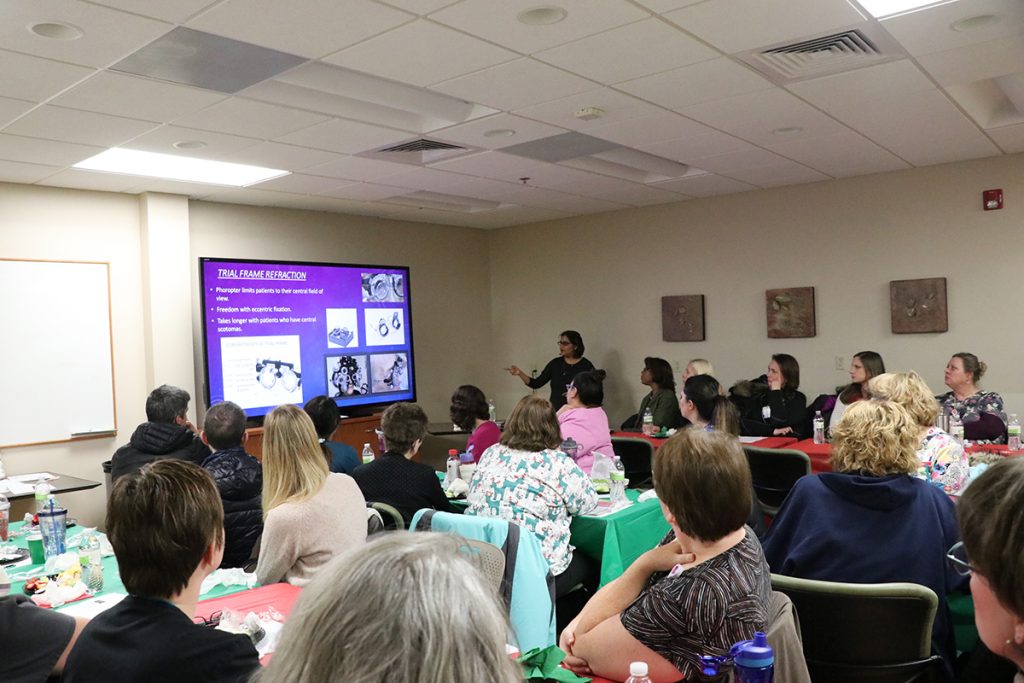A year after Sanbrita Mondal, OD, started the Low Vision Rehabilitation Clinic at UW Health University Station Eye Clinic in Madison, it is now fully operational, holding diagnostic clinics for patients with visual disabilities every Friday. This clinical initiative is augmented by a recent partnership with the Vision Rehabilitation Network through the Lighthouse Guild International, a non-profit vision health advocate and funder. The Network’s objectives are to provide ophthalmologists, optometrists and technicians with knowledge and tools to identify and support patients with visual impairment using best practices.
Dr. Mondal has held training sessions at two clinic locations in the department since December 2017, with a planned two-part series to occur at all UW Health Eye Clinics in the spring and fall of 2018. The most recent training session drew an audience of more than 40 eye care professionals. Dr. Mondal covered a wide range of topics, beginning with the standard definition of low vision (a person who, even with correction, has a Snellen visual acuity of 20/70 or poorer in the better-seeing eye), to providing a comprehensive list of regional resources for visually impaired patients.

Dr. Mondal identified various eye pathologies that may cause visual impairment that cannot be addressed with surgery, glasses, or contact lenses. She demonstrated what a patient may actually see through various stages of visual degeneration. Dr. Mondal described a variety of diagnostic tools she uses to evaluate the patient’s functional vision, not only in a general sense, but also as a way to identify the patient’s unique issues to customize a care plan. Examples in her presentation included impaired contrast sensitivity such as in reading materials with low contrast between the letters and paper.
Dr. Mondal also called attention to lifestyle issues low vision patients may encounter.
“EYE CARE PROFESSIONALS TEND TO FOCUS ON HOW TO CORRECT EYE STRUCTURAL PROBLEMS, CURE EYE DISEASE AND PERHAPS PREVENT FUTURE EYE TISSUE DEGENERATION,” NOTES DR. MONDAL. “THERE ARE DEVICES AND STRATEGIES THAT CAN BENEFIT LOW VISION PATIENTS WHEN A CURE IS NOT OR NO LONGER POSSIBLE – SUCH AS using MAGNIFIERS, TELESCOPES, ENHANCED LIGHTING, AND EXAGGERATed CONTRAST THAT CAN MAINTAIN OR IMPROVE QUALITY OF LIFE.”
In Madison, the Wisconsin Council of the Blind & Visually Impaired provides devices and tools that can improve visual function, and has a certified low vision therapist who provides training on how to use them. Additional statewide institutional resources, especially for children, are available at Vision Forward in Milwaukee and The Wisconsin Center for the Blind & Visually Impaired in Janesville.
In addition to support for patient diagnostic and care services, providing training for eye care professionals, and supporting other community health resources, the Lighthouse Guild Vision Rehabilitation Network provides an online curriculum for training ophthalmology residents, as well as support for research in gathering and analyzing data from patient encounters to identify needs for specific community services.
To learn more about Low Vision and our clinic at UW-Madison, click here. Dr. Mondal will present, “The Low Vision Patient: Learning New Tricks,” with a clinical introduction by Mihai Mititelu, MD, MPH, at the weekly UW-Madison Department of Ophthalmology and Visual Sciences Ophthalmology Grand Rounds on March 9, 2018.